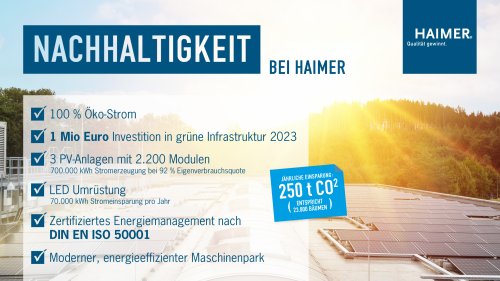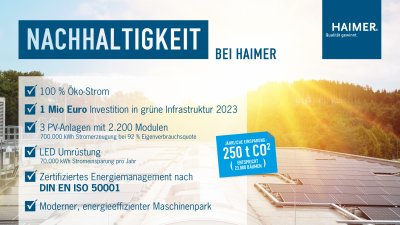Keeping an eye on the entire process

Sustainability considerations are currently “trendy”. Machining and the equipment used for it are no exception. Individual elements – such as tool holding – are often considered. However, if you really want to act sustainably, you should not focus too much on such details, otherwise you may miss out on advantages in the overall process.
Sustainability is a topic that is rightly becoming more and more important to us. Resources are limited and energy is increasingly expensive. When evaluating sustainability, it is important not to focus too narrowly on a product, but also to consider the environment – the product life cycle and the entire process in which the product is integrated.
How does sustainability look in machining?
Metal machining has many facets. Depending on the material, component geometry and quantities, a wide variety of machines, tools and clamping devices are used. External circumstances such as the production location, the qualifications of the employees and possible automation must also be taken into account. There are many different manufacturing options that can be the best, most economical and most sustainable solution depending on the individual case. It is difficult not to compare apples with oranges here.
How is sustainability measured? Apart from the used materials, energy efficiency is probably the main factor that determines a sustainable process. Therefore, a promising approach is to look for the largest consumers and optimize their use.
The machine tool offers savings potential
In machining, this is undoubtedly the machine tool, which consumes the majority of the energy used with its spindle and axis drives, peripherals and auxiliary units such as cooling, lubrication or compressed air supply.
When purchasing new machines, the user can significantly reduce consumption by paying attention to energy-saving components. Andreas Haimer, Managing Director and President of the HAIMER Group, the market leader in tool holding technology, explains: “In our own production, we have learned that replacing an old machining center with a new one using the same machining process requires around 30 percent less energy.” He adds another fundamental factor: “As a family business, we pay a lot of attention to sustainability. For example, we source our steel for tools from Germany, have been using electricity exclusively from renewable energy sources for years and are investing in solar energy systems and green infrastructure. In the last financial year, we invested a total of over one million euros and saved over 250 tons of CO2 per year.”
Back to the machinery, where not every older machining center can be replaced by a new one. Savings can also be made in the machining process, for example by using CAD/CAM-optimized machining strategies such as trochoidal milling. Andreas Haimer has a concrete example: “A customer provided us with data on how he was able to reduce the machining time by 75 percent from 71 minutes to 18 minutes per part by trochoidal milling with our HAIMER Power shrink fit chucks and HAIMER MILL cutters compared to machining with a face mill cutter The change in machining strategy was accompanied by energy savings due to significantly lower power consumption. While the spindle load was 80-85% for 10 parts in conventional machining with a face mill cutter, resulting in total energy costs of around EUR 150, the trochoidal milling strategy with a spindle load of 8-10% and significantly shorter machine running time reduced energy costs to a total of EUR 5 for 10 parts. This in turn means a higher output with lower energy consumption per part produced – that’s what I call sustainable and efficient.”
The sustainability of tool holding: A holistic approach
If you look at the whole process chain, have you ever thought about how a tool holder could contribute to sustainability? In view of a machining process in which the milling machine consumes an average of around 30 kW, plus the power of hydraulic and pneumatic devices, automation equipment and robots, tool holding only plays a subordinate role. This is because the tool holder is a comparatively small detail, even if the clamping process with a shrink fit chuck consumes a marginal amount of energy.
Looking at other clamping systems, the energy consumption during shrinking is higher in operational use than with a hydraulic or milling chuck. If you look at the entire product life cycle of a tool holder, which includes production, maintenance and disposal, a completely different picture emerges.
The production of a hydraulic chuck requires significantly more effort and energy due to its more complicated structure. In addition to the high-precision machining of individual components, there is also the soldering of the expansion sleeve, additional heat treatment to prevent the solder joint from breaking, as well as the effort required for cleaning, assembly and filling with oil. “From our experience, the energy required for production is around three times as high as for the shrink fit chuck,” explains Andreas Haimer. “In addition to shrink fit chucks, we also have hydraulic chucks in our extensive portfolio, although their list prices are two to three times higher than shrink fit chucks due to the complex production process. They are the right solution for certain applications. However, they are not more sustainable. Our analyses have shown that a hydraulic chuck requires approx. 25 kWh more energy to manufacture than a shrink chuck. Conversely, in terms of the product life cycle, this means that a shrink fit chuck with an energy requirement of 0.026 kWh per shrink fit and cooling cycle can be shrunk almost 1,000 times before it requires more energy than a hydraulic chuck.” The same applies to milling chucks, which are much more complicated and contain more components as well as grease and lubricants.
Life cycle and process reliability are crucial
In addition to the increased manufacturing costs, there is also the difference in terms of maintenance. While Haimer shrink chucks are maintenance-free due to the particularly high quality of the hot-work tool steel and, in combination with the patented Haimer coil and shrink fit machine technology, they can be shrunk in and out an unlimited number of times, whereas hydraulic chucks and milling chucks have to be returned to the manufacturer every 2-3 years at the latest to check the clamping force, lubricate the clamping screw or grease the system and carry out regular maintenance of the chuck due to wear. The contained hydraulic fluid or grease also makes environmentally friendly disposal more difficult than with shrink fit chucks, which do not contain any additional components. In addition to the life cycle, there are also significant differences in terms of process reliability: in the event of dry machining or insufficient cooling in the machining process, hydraulic chucks pose the risk of the clamping chambers bursting due to the high heat development, including tool pull-out and the risk of scrap. Shrink fit chucks are more robust and durable in this respect; if you want to completely eliminate the risk of tool pull-out, the Haimer Safe-Lock system is available as an option for shrink fit chucks for 100% safety.
Energy consumption in perspective
But how is energy consumption really calculated during the shrinking process? Heating a shrink fit chuck takes about 5 seconds with a current HAIMER shrink fit machine. Experienced users shrink a worn cutting tool and shrink a new cutting tool in a single operation. The tool holder is therefore only heated and cooled once. The maximum output of a HAIMER Power Clamp shrink fit machine with the patented NG coil is 13 kW, but the average is 8 kW. This means that a single, complete shrinking process consumes around 0.011 kWh. On top of this, cooling consumes around 0.015 kWh – although Haimer devices can cool up to five holders in parallel and at the same time with almost the same energy consumption. In the worst-case scenario, this results in a total of 0.026 kWh for the entire process. If a kilowatt hour costs 20 cents, shrinking and cooling a tool costs a marginal 0.5 cents.
And how should the energy consumption be classified when considering the machining process, in which the power consumption of a milling machine with all auxiliary drives is around 30 kW? Assuming that a tool is in use for approx. 1 hour and that even just one percent of the machining time can be saved thanks to the high concentricity and rigidity or the improved milling strategies due to the slim contour, that would be 0.3 kWh of energy saved. This is approximately 11 times the amount of energy used for shrinking.
Andreas Haimer summarizes: “The energy consumption per clamping process plays a negligible role compared to the issues of life cycle, process reliability and machining strategy. Modern CAD/CAM-optimized milling strategies can save 75 percent of machining time. Machinists must focus on such improved processes if they want to be sustainable and productive. And in a second step, they should select the most suitable and process-reliable tool holder for these strategies”
###

Sustainability at HAIM ER
In 2023, HAIMER invested more than one Million Euros in green infrastructure. Among other things, the solar energy system was extended to other buildings and converted to LED lights. This will save more than 250 tons of CO2 per year.

Andreas Haimer with new hybrid chuck
Andreas Haimer, President of the HAIMER Group, with a new hybrid chuck: “We have a very wide range of different tool holders. These include many different shrink fit chucks, but also hydraulic chucks. At EMO, we presented a world first with the HAIMER Hybrid Chuck. It combines the vibration-damping properties of a hydraulic chuck with those of a high-precision, high-performance shrink fit chuck, opening up many possibilities for making the machining process even more efficient and sustainable.”
Further information on the company, technology and products can be obtained directly from Haimer GmbH. Please contact k+k-PR GmbH if you have any questions about text and images. We would be pleased to receive your publication. Reprint free of charge. Please send a copy to:
k+k-PR GmbH
Peter und Wolfgang Klingauf
Von-Rad-Str. 5 f
D-86157 Augsburg
Tel.: +49 (0)8 21 / 52 46 93
Fax.: +49 (0)8 21 / 22 93 96 92
E-Mail : info@kk-pr.de
www.kk-pr.de
About HAIMER
HAIMER is a family run, medium-sized company located in Igenhausen, Bavaria near Augsburg, Germany. It designs, produces and sells innovative, high-precision products for metal cutting as well as for other industrial branches including automotive, aerospace, energy, rail and general machining. The product range includes a wide variety of tool holders in all popular interfaces and lengths, solid carbide cutting tools, shrink fit and balancing machines as well as 3D sensors and tool presetting machines from HAIMER Microset.
Of approx. 800 employees worldwide, 500 work at the production facility in Igenhausen together with the most modern of machines and a high level of automation. HAIMER Microset presetting machines are produced at the second HAIMER production site in Bielefeld, with around 50 employees. The experienced, dynamic and highly qualified employees guarantee the well-known and highest quality “made by HAIMER.” As an active apprenticeship company, with almost 50 apprentices and a high rate of hiring, HAIMER is able to secure its future skilled employees and to fulfill its contribution to further educate young adults, as well as securing the future of the German manufacturing location. As the European market leader in the area of tool holding technology, with a daily capacity of approx. 4,000 tool holders, keeping the technological edge of our products is very important to HAIMER. Because of this, every year between 8 and 10% of the revenue is invested in research and development. The daily desire to be better fits works perfectly with the corporate philosophy: Quality wins.
Haimer GmbH
Weiherstr.21
86568 Igenhausen
Völker Tobias
Phone : +49 (0) 82 57 / 99 88-0
Fax : +49 8257 1850
tobias.voelker@haimer.de
